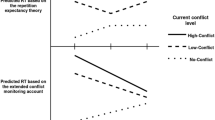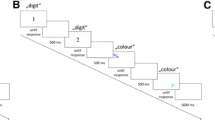Abstract
Studies have suggested that conflict control can modulate conflict effects in response to differing levels of conflict context. The current study probed, in two experiments of proportion congruence, the relevance of both task conflict (between a currently relevant task and irrelevant task alternatives) and response conflict (between a currently relevant response and irrelevant response alternatives) to conflict control. In Experiment 1, proportion congruence between blocks was manipulated and in Experiment 2, proportion congruence was manipulated between items. The response conflict effect was smaller when proportion of incongruence was high, regardless if task conflict or response conflict proportions were manipulated. These findings suggest that both task conflict and response conflict are monitored but that only response conflict is being influenced by this monitoring process. Theoretical implications are discussed.




Similar content being viewed by others
References
Akćay, C., & Hazeltine, E. (2008). Conflict adaptation depends on task structure. Journal of Experimental Psychology: Human Perception and Performance, 34, 958–973.
Botvinick, M. M., Braver, T. S., Barch, D. M., Carter, C. S., & Cohen, J. D. (2001). Conflict monitoring and cognitive control. Psychological Review, 108, 624–652.
Braver, T. S. (2012). The variable nature of cognitive control: a dual mechanisms framework. Trends in Cognitive Sciences, 16, 106–113.
Braverman, A., & Meiran, N. (2010). Task conflict effect in task switching. Psychological Research, 74, 568–578.
Crump, M. J. C., Gong, Z., & Milliken, B. (2006). The context-specific proportion of congruent Stroop effect: location as a contextual cue. Psychonomic Bulletin and Review, 13(2), 316–321.
Desmet, C., Fias, W., Hartstra, E., & Brass, M. (2011). Errors and conflict at the task level and the response level. The Journal of Neuroscience, 31, 1366–1374.
Dreisbach, G., Goschke, T., & Haider, H. (2007). The role of task rules and stimulus-response mappings in the task switching paradigm. Psychological Research, 71(4), 383–392.
Egner, T. (2008). Multiple conflict-driven control mechanisms in the human brain. Trends in Cognitive Sciences, 12(10), 374–380.
Eriksen, C. W. (1995). The flankers task and response competition: a useful tool for investigating a variety of cognitive problems. Visual Cognition, 2, 101–118.
Funes, M. J., Lupiáñez, J., & Humphreys, G. (2010). Sustained vs. transient cognitive control: evidence of a behavioural dissociation. Cognition, 114, 338–347.
Goldfarb, L., & Henik, A. (2007). Evidence for task conflict in the Stroop effect. Journal of Experimental Psychology: Human Perception and Performance, 33, 1170–1176.
Gratton, G., Coles, M. G., & Donchin, E. (1992). Optimizing the use of information: strategic control of activation of responses. Journal of Experimental Psychology: General, 121, 450–480.
Jacoby, L. L., Lindsay, D. S., & Hessels, S. (2003). Item-specific control of automatic processes: stroop process dissociations. Psychonomic Bulletin and Review, 10, 638–644.
Kalanthroff, E., & Henik, A. (2013). Preparation time modulates pro-active control and enhances task conflict in task switching. Psychological Research, 78, 276-288.
Kalanthroff, E., Goldfarb, L., & Henik, A. (2012). Evidence for interaction between the stop signal and the Stroop task conflict. Journal of Experimental Psychology: Human Perception and Performance, 39(2), 579–592.
Kerns, J. G., Cohen, J. D., MacDonald, A. W, I. I. I., Cho, R. Y., Stenger, V. A., & Carter, C. S. (2004). Anterior cingulate conflict monitoring and adjustments in control. Science, 303, 1023–1026.
Kiesel, A., Steinhauser, M., Wendt, M., Falkenstein, M., Jost, K., Philipp, A. M., et al. (2010). Control and interference in task switching––a review. Psychological Bulletin, 136, 849–874.
Koch, I., Gade, M., Schuch, S., & Philipp, A. M. (2010). The role of inhibition in task switching: a review. Psychonomic Bulletin and Review, 17, 1–14.
Kornblum, S., Hasbroucq, T., & Osman, A. (1990). Dimensional overlap: cognitive basis for stimulus-response compatibility––a mode l and taxonomy. Psychological Review, 97, 227–253.
Logan, G. D., & Zbrodoff, N. J. (1979). When it helps to be misled: facilitative effects of increasing the frequency of conflicting stimuli in a Stroop-like task. Memory and Cognition, 7, 166–174.
Lu, C. H., & Proctor, R. W. (1995). The influence of irrelevant location information on performance: a review of the Simon and spatial Stroop effects. Psychonomic Bulletin and Review, 2, 174–207.
MacLeod, C. M. (1991). Half a century of research on the Stroop effect: an integrative review. Psychological Bulletin, 109, 163–203.
Meiran, N. (2010). Task switching: mechanisms underlying rigid vs. flexible self control. In R. Hassin, K. Ochsner, & Y. Trope (Eds.), Self control in society, mind and brain (pp. 202–220). New York: Oxford University Press.
Meiran, N., & Kessler, Y. (2008). The task rule congruency effect in task switching reflects activated long term memory. Journal of Experimental Psychology: Human Perception and Performance, 34, 137–157.
Monsell, S. (2003). Task switching. Trends in Cognitive Sciences, 7, 134–140.
Monsell, S., Taylor, T., & Murphy, K. (2001). Naming the color of a word: is it responses or task sets that compete? Memory and Cognition, 29, 115–137.
Notebaert, W., & Verguts, T. (2008). Cognitive control acts locally. Cognition, 106, 1071–1080.
Schmidt, J.R. (2013). Questioning conflict adaptation: proportion congruent and Gratton effects reconsidered. Psychonomic Bulletin and Review, 20(4), 615–630.
Schneider, D. W., & Logan, G. D. (2005). Modeling task switching without switching tasks: a short-term priming account of explicitly cued performance. Journal of Experimental Psychology: General, 134, 343–367. doi:10.1037/0096-3445.134.3.343.
Steinhauser, M., & Huebner, R. (2009). Distinguishing response conflict and task conflict in the Stroop task: evidence from ex Gaussian distribution analysis. Journal of Experimental Psychology: Human Perception and Performance, 35, 1398–1412.
Sternberg, S. (1969). Memory scanning: mental processes revealed by reaction-time experiments. American Scientist, 57, 421–457.
Torres-Quesada, M., Funes, M. J., & Lupiáñez, J. (2013). Dissociating proportion congruent and conflict adaptation effects in a Simon-Stroop procedure. Acta Psychologica, 142, 203–210.
Townsend, J. T., & Nozawa, G. (1995). On the spatio-temporal properties of elementary perception: an investigation on parallel, serial, and coactive theories. Journal of Mathematical Psychology, 39, 321–359.
Tzelgov, J., Henik, A., & Berger, J. (1992). Controlling Stroop effects by manipulating expectations for color words. Memory and Cognition, 20, 727–735.
Author information
Authors and Affiliations
Corresponding author
Appendix
Appendix
The purpose of the Appendix is to describe the proofs of why response repetition could not explain the conflict adaptation results found in Experiment 2. Without loss of generality, let us consider just the item proportion manipulation (Experiment 2) and the UP–DOWN task in a particular configuration of the experiment.
Response congruence manipulation
When the UP target stimulus is mostly response congruent, ↑ appears in 35 % of the trials and ↓ appears in 15 % when the correct response is UP. In this case, the DOWN target stimulus will be mostly response incongruent, so that ↑ appears in 35 % and ↓ appears in 15 % when the correct response is DOWN. Note that, for the UP–DOWN task, the proportions are the same for both UP and DOWN target stimuli and ↓ is more frequent than ↑. Consequently, the arrows are completely uninformative with respect to the correct response. The arrows do prime a specific response (↑ is more frequent than ↓, but regardless of proportion congruency). Moreover, since participants were assigned to different task configurations in a random order, there was no systematic higher proportion of a given arrow across participants.
Task conflict manipulation
When the UP target stimulus is mostly task congruent, ↕ appears in 35 % of the trials and ↔ appears in 15 % when the correct response is UP. In this case, the DOWN target stimulus is mostly task incongruent, so that ↔ appears in 35 % and ↕ appears in 15 % when the correct response is DOWN. Note that, for the UP–DOWN task ↕ appears more often when the correct response is UP and ↔ appears more often when the correct response is DOWN. Therefore, the interfering arrows do predict the correct response in this case. Note that when the proportion of task conflict was manipulated for UP and DOWN, the proportion of response conflict was 25:25 for these targets. The single-headed arrows serving to produce RCE were uninformative. Hence, RCE should have been unaffected, but it was affected. Moreover, in this case TCE should have been affected, but it was not. Note that, in this case, the proportion manipulation should have influenced TCE, but it did not.
Rights and permissions
About this article
Cite this article
Braverman, A., Meiran, N. Conflict control in task conflict and response conflict. Psychological Research 79, 238–248 (2015). https://doi.org/10.1007/s00426-014-0565-5
Received:
Accepted:
Published:
Issue Date:
DOI: https://doi.org/10.1007/s00426-014-0565-5




